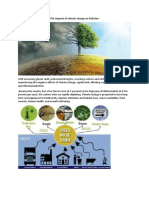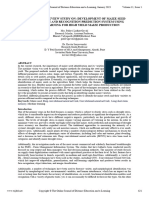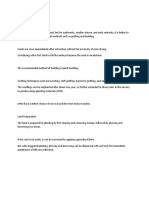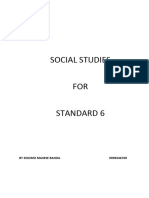Climate Variability
Climate Variability
Uploaded by
Faiz M TaimurCopyright:
Available Formats
Climate Variability
Climate Variability
Uploaded by
Faiz M TaimurOriginal Description:
Copyright
Available Formats
Share this document
Did you find this document useful?
Is this content inappropriate?
Copyright:
Available Formats
Climate Variability
Climate Variability
Uploaded by
Faiz M TaimurCopyright:
Available Formats
CLIMATE CHANGE CELL KEY FACTS
Climate Variability and Change in Bangladesh
Impacts, Vulnerability and Risks
The global climate is changing and it is likely to change further over coming decades due to increasing concentrations of greenhouse gases in the earths atmosphere caused largely by human activities. This will result in greater variations in weather patterns, a greater frequency of extreme weather events such as floods, droughts and tropical storms, and gradual rises in average temperatures and sea-levels. Bangladesh is extremely vulnerable to climate change impacts because of its geographical location, high population density, high levels of poverty, and the reliance of many livelihoods on climate-sensitive sectors, particularly rural agriculture and fisheries. These impacts will be falling more heavily on the women and girls of Bangladesh. Climate change therefore threatens both previous achievements and future efforts to reduce poverty in Bangladesh to date, particularly by reducing water and food security and damage to essential infrastructure during more frequent disaster events. Bangladesh has always been vulnerable to climate variability. This is due to its geographical features and location, high influence of monsoon and regional flow patterns, too much water in monsoon and too little water in the dry season, etc. These have significant effects on the socio-economic realities, i.e. population density, inequity and deprivation, poverty and per capita resource endowment, and development practices. The overall impacts on Bangladesh already are and will be significant since climate variability and change will significantly affect the hydrology. The location of the country in the regional setting is in itself an element of vulnerability by giving rise to climate extremes. Further, the regional aspects of water management put additional difficulty toward adaptation to climate change and climate variability.
Too much water during monsoon
The climate of the country is strongly influenced by monsoon. Though Bangladesh occupies only 7% of the combined catchment area of the Ganges-Brahmaputra-Meghna river basin, the country has to drain out 92% of the flow into the Bay of Bengal. Too much water in the monsoon period affects different sectors, livelihoods and food security. Climate change scenario projections show mean monthly rainfall may significantly change over normal (i.e. current variability). Monsoon rainfall may increase by 11% by 2030 and 27% by 2070. Also, the general rise in surface average temperature will increase by 1.3 degree C by 2030 and 2.6 degree C by 2070. The number of rainy days will increase by about 20 days. Implication of these climate change scenarios is that about 18 percent of current lowly flooded areas will be susceptible to higher levels of flooding while 12 to 16 percent new areas will be at risk to inundation. On an average about a quarter of the countrys landmass is currently flood prone in a normal hydrological year, which may increase to 39 percent, while the frequency of a catastrophic flood (affecting over two-third of the landmass of the country) could increase under climate change scenarios. Prolonged flooding can effectively reduce overall potential for HYV Aman production.
Flood prone areas in Bangladesh
Too little water during the dry season
During the post-monsoon to pre-monsoon cycle, rainfall diminishes while temperature increases. Low rainfall runoff reduces river flows, consequently salinity penetrates along the coastal rivers. A combination of increased temperature and reduced rainfall results in an increase in evapo-transpiration, detrimental to crop growth. Under climate change scenario projections, already low rainfall in the dry season will be further diminished. However, winter and premonsoon temperatures will rise significantly. The following consequences are possible: A sharp rise in evapo-transpiration and diminishing rainfall will further reduce available flows in rivers. As a result, salinity will penetrate inland, restricting choice for the most preferred crops. Also, the lowering of rainfall runoff will either limit irrigation or put increased economic constraints on the already poor farmer. Production of wheat, HYV Aus and Boro might no longer be economically suitable under climate change. Increased surface temperature will lead to release of more carbon from the topsoil, which in turn will reduce fertility of soils. Increased water demand for irrigation will lead to increased withdrawal from the already lean surface water systems leading to further decrease in lean season flow in the rivers. An additional quarter of a million hectare land will become affected by salinity, on top of the 3.05 million hectares already affected. This will force farmers to grow crops of economically lesser returns. Drought prone areas in Bangladesh
Impact of drought on agriculture and crop production
Implication for the Sunderbans and biodiversity
Lean flow in the distributaries of Ganges will jeopardize the forest succession processes in the Sunderbans, resulting in low productivity and poor vegetative cover of the forest. This will in turn affect the rich biodiversity of the forest.
Implication for human health
High salinity in water, in both surface and groundwater sources in the southwestern areas of Bangladesh is affecting human health. What will happen if salinity penetrates further inland under climate change? The rise in temperature will favor pest and pathogen activities and human health will be at higher risk, i.e. increased risk of dengue, malaria, diarrhea, etc. Recurring floods will tend to destroy poor sanitation infrastructure and facilities. Cyclones with increased vigor will also have similar effects. Reaching the MDG targets will be extremely difficult under climate change conditions.
Sea Level Rise
The projected sea level rise (SLR) along the coastal areas of Bangladesh will be about 88 cm by the year 2100. If this comes true, a majority of the low-lying non-embanked coastal areas may be completely inundated. There will be increasing risk of coastal salinity (both soil as well as surface water, including drinking water from wells). Scarcity of saline free drinking water will be even more pronounced. SLR will have compounding effects on coastal drainage and erosion. The mixing zone between fresh (sweet) water and saline water will also shift. Land use suitability, particularly in relation to current agricultural practices will change. Embanked coastal agricultural areas will be at higher risk of tidal surge and subsequent inundation with saline water. SLR will cause shoreline retreat, resulting in increase in basin area, which contributes to increasing the cyclone path length. This will allow the cyclone to remain more time in the water, acquire and release more latent heat, resulting in more energy, intensity and wind speed. Cyclone prone areas in Bangladesh
Conclusion
In conclusion, water resources and hydrology of Bangladesh are highly sensitive to current climate variability. Within Bangladesh, climate variability has two major dimensions temporal and spatial. Both are highly significant. There are various elements of vulnerability associated to current climate variability. Under climate change, observed climate variability will increase causing extreme climate conditions. Floods, droughts and salinity ingress will occur more frequently and with higher intensity. The country has to implement adaptation measures in order to reduce its current variability and change. In relation to the southwest region of Bangladesh, the implications as the maximum impact zone is higher salinity, choking up of small rivers, water logging, embankment breaching and overtopping, cyclonic storm surges, riverbank erosion. Agriculture will be severely affected. Upper reaches will face drought conditions. A major challenge will be to assure saline free drinking water to the population and ecosystem.
ABOUT CLIMATE CHANGE CELL The Climate Change Cell has been established in the Department of Environment in 2004 under the Comprehensive Disaster Management Program (CDMP) of the Government. It responds to the recognition that Bangladesh is particularly vulnerable to the effects of climate change, and that the number and scale of climate-related disasters is likely to increase. The Cell provides the central focus for the Governments climate change related work, operating as a unit of the Department of Environment (DoE) under the Ministry of Environment and Forests (MoEF). Its objective is to enable the management of long term climate risks and uncertainties as an integral part of national development planning. This will contribute to the primary objective of the wider Comprehensive Disaster Management Programme, which aims to strengthen the capacity of the Bangladesh disaster management system to reduce unacceptable risks and improve response and recovery activities. Building the capacity of Government Strengthening existing knowledge and availability of information on impact prediction and adaptation to climate change. Awareness raising, advocacy and coordination with partners across government, NGOs, civil society, private and donor organizations. Improving capacity to adapt livelihoods to climate change in the agriculture sector
Published by CLIMATE CHANGE CELL, Component 4B of COMPREHENSIVE DISASTER MANAGEMENT PROGRAMME CDMP @ JUNE 2006
PREPARING FOR CLIMATE CHANGE
You might also like
- Georgraphy High School Syllabus: Republic of ZambiaDocument18 pagesGeorgraphy High School Syllabus: Republic of ZambiaDavid RayNo ratings yet
- 6 MallickDocument4 pages6 MallickSaiduzzaman Khan TuhinNo ratings yet
- Brief On Climate Change - Impact On BangladeshDocument4 pagesBrief On Climate Change - Impact On BangladeshNilantiNo ratings yet
- Bangladesh's Geographical LocationDocument4 pagesBangladesh's Geographical Locationshadman sakibNo ratings yet
- Climate of Bangladesh PresentationDocument22 pagesClimate of Bangladesh Presentationapi-3748626100% (2)
- The Consequences Bangladesh Is Facing Because of Climate ChangeDocument1 pageThe Consequences Bangladesh Is Facing Because of Climate ChangepaponfkbNo ratings yet
- AssaignmentDocument7 pagesAssaignmentMd. Sweet AhmedNo ratings yet
- Climate ChangeDocument14 pagesClimate ChangeEhsanuzzaman SimonNo ratings yet
- Global Warming and Climate Change in KenyaDocument10 pagesGlobal Warming and Climate Change in KenyaStephen BaronNo ratings yet
- Climate Change & Its Impacts On Bangladesh: Moniza BiswasDocument10 pagesClimate Change & Its Impacts On Bangladesh: Moniza BiswasMdsadmaNo ratings yet
- Agriculture Is A Key Economic Driver in Bangladesh, Accounting For Nearly 20 Per Cent of TheDocument4 pagesAgriculture Is A Key Economic Driver in Bangladesh, Accounting For Nearly 20 Per Cent of TheSuvro AvroNo ratings yet
- Env Climate Change ReportDocument10 pagesEnv Climate Change ReportSadman Sharar 1931037030No ratings yet
- Climate Change and Its Global Impact IntroductionDocument8 pagesClimate Change and Its Global Impact Introductionreajeanlambayan123No ratings yet
- Climate Change in BangladeshDocument7 pagesClimate Change in BangladeshMd. Sweet AhmedNo ratings yet
- Climate Change Impacts - Central Asia - : AgricultureDocument3 pagesClimate Change Impacts - Central Asia - : AgricultureafarhadNo ratings yet
- 2.0 Potential Threat From Climate Change in MalaysiaDocument8 pages2.0 Potential Threat From Climate Change in MalaysiaDayang Suzica Ahmad SafuanNo ratings yet
- Climate ChangeDocument18 pagesClimate ChangeRayonNo ratings yet
- Drought in Bangladesh and Its Adaptive Measures: Part-ADocument4 pagesDrought in Bangladesh and Its Adaptive Measures: Part-ASADIA AFRINNo ratings yet
- Climate Change and Global Warming and Its Impact On BangladeshDocument7 pagesClimate Change and Global Warming and Its Impact On BangladeshAminulHoqueNo ratings yet
- Why Bangladesh Is One of The Most Vulnerable Countries To Climate ChangeDocument29 pagesWhy Bangladesh Is One of The Most Vulnerable Countries To Climate ChangesaharabellaNo ratings yet
- The Impact of Geographic Features on BengalDocument3 pagesThe Impact of Geographic Features on Bengalrimarahman413No ratings yet
- Pop 108 FinalDocument41 pagesPop 108 FinalabeeraalimintaeNo ratings yet
- 8-Climate Change and Its Impact With Special Focus in PakistanDocument19 pages8-Climate Change and Its Impact With Special Focus in PakistanqayoomsohooNo ratings yet
- Climate Action South Asia: Information Update No. 3 (The Economics of Climate Change in South Asia)Document8 pagesClimate Action South Asia: Information Update No. 3 (The Economics of Climate Change in South Asia)Asian Development BankNo ratings yet
- An Assignment On Climate Change and Its Impact in Bangladesh PerspectivesDocument9 pagesAn Assignment On Climate Change and Its Impact in Bangladesh Perspectivesal aminNo ratings yet
- Climate ChangeDocument13 pagesClimate ChangeHayat Omer MalikNo ratings yet
- Climate Change Impact and Agriculture of PDFDocument6 pagesClimate Change Impact and Agriculture of PDFNilantiNo ratings yet
- Climate Change in BANGLADESHDocument9 pagesClimate Change in BANGLADESHSaifSaemIslamNo ratings yet
- Changes of Water Due To Climate ChangeDocument26 pagesChanges of Water Due To Climate ChangeMahesh PrinceNo ratings yet
- Impact of Climate Change On The Indian EconomyDocument3 pagesImpact of Climate Change On The Indian Economyarulark2002No ratings yet
- RJAPS V27 SahaDocument14 pagesRJAPS V27 SahaAyesha SiddiquaNo ratings yet
- Sustainability 13 12037Document21 pagesSustainability 13 12037Marco Jenpaul PIO SANTIAGONo ratings yet
- Climate Change and Its Impact On Geographical Features: Special ArticleDocument4 pagesClimate Change and Its Impact On Geographical Features: Special Articlesubhadeep sarkarNo ratings yet
- Assignment No 1Document4 pagesAssignment No 1m2023bsass033No ratings yet
- 10.ClimatechangeimpactonhorticulturalcropsDocument12 pages10.Climatechangeimpactonhorticulturalcropsbamidelelawrence114No ratings yet
- Climate Change & Global ConflictDocument29 pagesClimate Change & Global ConflictUsama Bin TariqNo ratings yet
- The Impacts of Climate Change On PakistanDocument4 pagesThe Impacts of Climate Change On PakistanIbtisam Ur RehmanNo ratings yet
- Background Research Paper On The Predicted Climate Change Impacts of Greatest Relevance To OxfamDocument8 pagesBackground Research Paper On The Predicted Climate Change Impacts of Greatest Relevance To OxfamOxfamNo ratings yet
- Background Research Paper On The Predicted Climate Change Impacts of Greatest Relevance To OxfamDocument8 pagesBackground Research Paper On The Predicted Climate Change Impacts of Greatest Relevance To OxfamOxfamNo ratings yet
- Background Research Paper On The Predicted Climate Change Impacts of Greatest Relevance To OxfamDocument8 pagesBackground Research Paper On The Predicted Climate Change Impacts of Greatest Relevance To OxfamOxfamNo ratings yet
- Esemen Earth N Space 2015Document11 pagesEsemen Earth N Space 2015Zulfazakmalhusna Ibnu MaiNo ratings yet
- Env 107Document2 pagesEnv 107Mohammed Abu Darda 2221486630No ratings yet
- Country Report: Bangladesh: Executive SummaryDocument18 pagesCountry Report: Bangladesh: Executive Summaryনাজমুল হক শাহিন0% (1)
- Impact of Climate Change On Water ResourcesDocument10 pagesImpact of Climate Change On Water ResourcesMuhammad HannanNo ratings yet
- Disaster 1Document8 pagesDisaster 1augustinmistry1834No ratings yet
- Climate Change and National Response BangladeshDocument20 pagesClimate Change and National Response BangladeshLaura DamayantiNo ratings yet
- The Impact of Climate Change On WaterDocument4 pagesThe Impact of Climate Change On Waterkizito olewuikeNo ratings yet
- Poster - Climate Change & Water - Nazam Maqbool (09.01.2023)Document1 pagePoster - Climate Change & Water - Nazam Maqbool (09.01.2023)Nazam MaqboolNo ratings yet
- Impact of Global Warming On Sunderban National ParkDocument3 pagesImpact of Global Warming On Sunderban National ParkHarsh NitureNo ratings yet
- News Report LayoutDocument2 pagesNews Report Layoutshohan hasiburNo ratings yet
- Chapter 4Document39 pagesChapter 4piercegalulaNo ratings yet
- Mercy Research Proposal CorrectedDocument13 pagesMercy Research Proposal CorrectedfayiahuriahNo ratings yet
- Effect of Global Warming On Livelihood - Case Study - Birnin Kudu September 14 Now-ReferenceDocument56 pagesEffect of Global Warming On Livelihood - Case Study - Birnin Kudu September 14 Now-Referenceshuaibu abdullahiNo ratings yet
- Climate Change in Bangladesh (Arif - 869)Document4 pagesClimate Change in Bangladesh (Arif - 869)MohaMmad RaIhanNo ratings yet
- Presentation 1Document5 pagesPresentation 1bg2s8cwqjmNo ratings yet
- Tapu's AssignmentDocument7 pagesTapu's AssignmentTapuNo ratings yet
- Ijsrp p8791Document6 pagesIjsrp p8791madiihahNo ratings yet
- Climate Change ImpactsDocument8 pagesClimate Change Impactskundayi shavaNo ratings yet
- Manoj Kumar Aquatic EcosystemDocument6 pagesManoj Kumar Aquatic Ecosystemanshgoyal226No ratings yet
- CLIMATE CHANGE Revised AssignmentDocument24 pagesCLIMATE CHANGE Revised Assignmentdh6467m7sfNo ratings yet
- Oceanic Oases Under Threat: Climate Change and its Toll on Mediterranean, Gulf, and Indian Ocean EnclavesFrom EverandOceanic Oases Under Threat: Climate Change and its Toll on Mediterranean, Gulf, and Indian Ocean EnclavesNo ratings yet
- Empire Emeraude RuleDocument18 pagesEmpire Emeraude RuletotocofeeNo ratings yet
- Report Assessment of Climate Change Vulnerability of Hakha Township ChinDocument124 pagesReport Assessment of Climate Change Vulnerability of Hakha Township ChinMay CheeNo ratings yet
- Santos Et Al. (2024) (Atmospheric Research)Document17 pagesSantos Et Al. (2024) (Atmospheric Research)Carlos CostaNo ratings yet
- Climate Smart AgricultureDocument111 pagesClimate Smart AgriculturemnarrosaNo ratings yet
- Barrio Maribeth Drought Tolerant Maize DTMADocument15 pagesBarrio Maribeth Drought Tolerant Maize DTMAMARKJUN BEDRONo ratings yet
- Importance of Variety Choice Adapting To Climate ChangeDocument7 pagesImportance of Variety Choice Adapting To Climate ChangeMarian RojasNo ratings yet
- Edu 4 You Smart Classes - LightDocument2 pagesEdu 4 You Smart Classes - LightRoxtteNo ratings yet
- Hydrometeorological Hazards BrochureDocument2 pagesHydrometeorological Hazards BrochureKizrah AragonNo ratings yet
- Disaster and Its TypesDocument27 pagesDisaster and Its TypesMuhammad MoizNo ratings yet
- A Literature Review Study On Development of Maize SeedDocument4 pagesA Literature Review Study On Development of Maize SeedNeguse MekonnenNo ratings yet
- Evs Chapter 3 and 4 NotesDocument22 pagesEvs Chapter 3 and 4 NotesJaya DasNo ratings yet
- Irrigation - Definition - Necessity - Advantage - DisadvantagesDocument21 pagesIrrigation - Definition - Necessity - Advantage - DisadvantagesHaider AliNo ratings yet
- Position PaperDocument2 pagesPosition Paperapi-340817333No ratings yet
- Managing Water Demands For A Rapidly Growing City in Semi-Arid Environment: Study of Las Vegas, NevadaDocument8 pagesManaging Water Demands For A Rapidly Growing City in Semi-Arid Environment: Study of Las Vegas, Nevadaይቴ ስንሻዉNo ratings yet
- Overcoming The Barriers: How To Ensure Future Food Production Under Climate Change in Southern AfricaDocument60 pagesOvercoming The Barriers: How To Ensure Future Food Production Under Climate Change in Southern AfricaOxfamNo ratings yet
- Chapter 6 - Disaster ManagementDocument40 pagesChapter 6 - Disaster Managementkirtanyash629No ratings yet
- Climate Change and Its Impact On Global Food SecurityDocument2 pagesClimate Change and Its Impact On Global Food Securitybhuwandutt98No ratings yet
- Guide in Growing DurianDocument8 pagesGuide in Growing DurianAeleen Nica SoroNo ratings yet
- The Plant Journal - 2006 - Verslues - Methods and Concepts in Quantifying Resistance To Drought Salt and Freezing AbioticDocument17 pagesThe Plant Journal - 2006 - Verslues - Methods and Concepts in Quantifying Resistance To Drought Salt and Freezing AbioticManuel MendezNo ratings yet
- English Mid-Term Exam: Choose The Correct Answer!Document4 pagesEnglish Mid-Term Exam: Choose The Correct Answer!nagaNo ratings yet
- Kumar Et Al. 2022Document11 pagesKumar Et Al. 2022Miguel OlivoNo ratings yet
- Amanda LittleDocument6 pagesAmanda LittlehosseinNo ratings yet
- STD 6-Social StudiesDocument48 pagesSTD 6-Social Studieslawrenceobote387No ratings yet
- Jasmine Rice: Adapting Rice Farming To Climate Change in Northeast ThailandDocument12 pagesJasmine Rice: Adapting Rice Farming To Climate Change in Northeast ThailandOxfamNo ratings yet
- The Hidden Driver: Climate Change and Migration in Central America's Northern TriangleDocument23 pagesThe Hidden Driver: Climate Change and Migration in Central America's Northern TriangleThe American Security ProjectNo ratings yet
- An Overview of Disaster ManagementDocument133 pagesAn Overview of Disaster Managementmanique_abeyrat2469100% (1)
- HSG Tiếng Anh 9 Tien Giang 2012Document12 pagesHSG Tiếng Anh 9 Tien Giang 2012hoanghnguyen88No ratings yet
- Module 5: Towards A Sustainable World: M5 Pre-Task: News ArticlesDocument4 pagesModule 5: Towards A Sustainable World: M5 Pre-Task: News ArticlesMin Jung YoonNo ratings yet
- Variations Among Coffee (Coffea Arabica L.) Genotypes For Sensitivity To Drought Induced by Soil Drying at Early Stages of Growth in EthiopiaDocument10 pagesVariations Among Coffee (Coffea Arabica L.) Genotypes For Sensitivity To Drought Induced by Soil Drying at Early Stages of Growth in EthiopiaPremier PublishersNo ratings yet

























































































